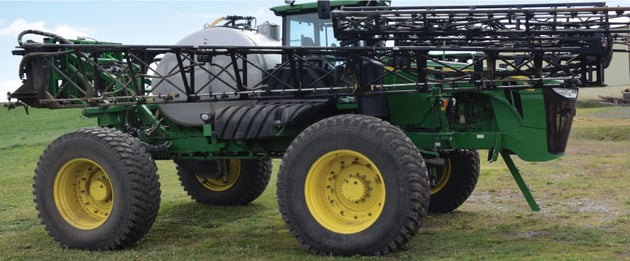Tips for Maximizing Your Sprayer's Tires
Farmers getting their sprayers ready for the field have a lot to think about: cleaning its tank, making sure its nozzles are flowing correctly, and checking its hoses, clamps, and mechanicals all top the list of things to go over before getting into the field. But what about your tires? Tires play a vital role in not only the performance of your sprayer, but also in the health of your fields. With that in mind, get ready to go back to sprayer school, and learn how to maximize your machine’s performance with Sprayer Tire 101.

One of the simplest and most effective ways to maximize the performance of your sprayer is by making sure its tires are set to the correct pressure. Tire pressure affects the size of your tire’s footprint and being incorrectly inflated can result in increased soil compaction, uneven wear, decreased traction, and higher fuel costs. Because of the general lack in productivity, we like to say that the price of a good tire pressure gauge pays for itself!
Of course, you’ll need to know your machine’s maximum speed and loaded weight to properly inflate its tires. If you have access to a grain scale, an easy way to get your machine’s weight is simply by loading it up and driving it to the scale. After you have the weight of the machine, check your tire manufacturer's website for the proper pressure. Then set your tires to the proper pressure and check them frequently—checking once a day is quick and can save you a lot of money in the long run.
Proper tire pressure is extremely important in relation to your tire’s tread. One of our favorite tests is this: with your sprayer fully loaded, run it on dry gravel and look at the tread. If your tire is properly inflated, dust from the gravel should cover your tire from edge to edge. If you just see a line of dust along the center of the tire, you’re overinflated. Another sure way to tell you’re running at an air pressure that’s too high is if the tire’s shoulders are lifted off of the ground.
Overinflation causes numerous problems for applicators, as it increases wear in the center of the tire, decreases traction, and places the weight of the machine in a concentrated area which is damaging to your soil. If you needed another reason to avoid over inflation, it also provides a rough ride and can be hard on your machine.
One of the things that sets us apart from the competition is our commitment to steel-belted tires. All of our IF/VF tires are steel belted. IF/VF tires are becoming increasingly common on sprayers, as they are perfect for managing the loads of today’s larger and heavier machinery while minimizing their impact on the soil. The steel belts in our IF/VF tires help them achieve a longer, more rectangular footprint, putting more of the tire on the ground for better traction and improved fuel consumption, not to mention reduced soil compaction and greater puncture resistance.
No matter if you're using a self-propelled or pull-behind sprayer, meeting the needs of today’s applicators has never been more challenging. Between the increasing size of sprayer tanks, the need to perform on the road and in the field, and the growing power of the machines themselves, we ask a lot of a sprayer’s tires. Because of this, it’s important to make sure you're getting the most out of yours. If you have questions about setting your sprayer tires to their optimal inflation or want to learn more about our line of sprayer tires, contact your local tire dealer today!


